
Do you want to know what’s on the GMAT? Do you have a general idea of the sections, but want to get a better idea of what to expect on test day? Are you confused about this whole ‘adaptive testing’ thing?
In this article, I’ll go over the GMAT structure and timing, the fundamentals of CAT (computerized adaptive testing), and a breakdown of the question types in each section of the test. Finally, I’ll discuss what the GMAT format means for you and offer tips on how to prepare for exam day.
Article Roadmap
- What is On the GMAT?: The Basics
- The GMAT is a Computerized Adaptive Test
- Breaking it Down: GMAT Sections and Question Types
- Tips: How to Make the GMAT Format Work for You
- Review: GMAT Format
What Is on the GMAT? The Basics
The GMAT has four timed sections, with two optional eight-minute breaks. Here’s a breakdown of the sections.
| Section | # of Questions | Time | Question Types | Score Range |
| Analytical Writing Assessment (AWA) | 1 Topic | 30 minutes | Analysis of Argument | 0-6 (in .5 increments) |
| Integrated Reasoning (IR) | 12 Questions | 30 minutes | Multi-Source Reasoning; Graphics Interpretation; Two-Part Analysis; Table Analysis | 1-8 |
| Optional Break | 8 minutes | |||
| Quantitative Section | 31 Questions | 62 minutes | Data Sufficiency; Problem Solving | 200-800 |
| Optional Break | 8 minutes | |||
| Verbal Section | 36 Questions | 65 minutes | Reading Comprehension; Critical Reasoning; Sentence Correction | 200-800 |
As you can see from the chart, the actual GMAT is just over three hours long. With breaks and sign-in time, ‘exam day’ usually takes about 3.5 to 4 hours.
As of July 2017, you can choose the order in which you complete the GMAT sections. Find out more about this change to the GMAT here.
Not sure how or what to study? Confused by how to improve your score in the shortest time possible? We've created the only Online GMAT Prep Program that identifies your strengths and weaknesses, customizes a study plan, coaches you through lessons and quizzes, and adapts your study plan as you improve.
We believe PrepScholar GMAT is the best GMAT prep program available, especially if you find it hard to organize your study schedule and don't want to spend a ton of money on the other companies' one-size-fits-all study plans.


What Is a Computerized Adaptive Test?
The GMAT is a CAT (Computerized Adaptive Test). This means that all parts of the GMAT are computerized, including the writing assessment. However, you only need basic computer know-how to take the GMAT. The exam is not technologically complicated.
You don’t need to learn any new skills if you can use a basic word processor/text editor (for the writing assessment), a standard calculator, and basic computer software. Essentially, you only need to know how to point, click, type, cut, and paste to successfully take the GMAT.
Note that there is no paper version of the GMAT. The GMAT is only delivered at Pearson VUE testing centers in a computerized adaptive format.
Computerized GMAT Exam Format: What to Expect
As I noted above, the computerized GMAT format is pretty straightforward overall: you type up your essay and then use drop down menus and simple multiple choice forms to select your answers for the other sections. Nonetheless, there are a couple of unique features and quirks you should be aware of.
A timer at the top righthand corner of your screen will keep track of how much time you have left in each section. You won’t get any other notifications about the time as you go along.
You will need to confirm each of your answers before you move on to the next question. When you’re satisfied with an answer, you’ll click ‘Next’ at the bottom righthand corner of your screen. A screen popup will ask if you are OK with your answer; you’ll click ‘yes’ or ‘no’ before moving on. This can throw some test-takers off at first, so it’s a good idea to practice with computer simulated tests to get the hang of it.
You can’t go back to previous questions once you’ve answered them. Even within the same section, you cannot go back to a previous question once you’ve confirmed your answer. This means you’ll have to be especially aware of the time as you complete each question.

Adaptive Testing: The Fundamentals
Adaptive testing is one of the major points of confusion for the average GMAT test-taker, but it’s not as complicated as it sounds. In a nutshell, ‘adaptive testing’ means that each test is individualized based on an algorithm that calculates a student’s ‘level’ as they answer questions of varying difficulty.
The GMAT begins each section by ‘assuming’ that the student is of average skill level and able to answer questions of medium difficulty. If the student answers most easy and medium questions correctly, the test adjusts to offer more difficult questions to place the student in his/her appropriate score range. If the student answers medium-level questions incorrectly, the test will adjust to offer the student easier questions.
This algorithm ultimately determines the student’s GMAT score for all the multiple-choice sections (Integrated Reasoning, Verbal, and Quantitative). The Analytical Writing Assessment is scored by live graders after the day of the test, so it’s not adaptive.
It is nearly impossible to determine how you’re doing as you go along and strategize accordingly, so it’s better not to try. It’s much harder than you might think to guess the difficulty of any given test question, especially under exam pressure and a time crunch. Even if you could tell whether a question is hard or easy, that knowledge is unlikely to make much difference in your ability to answer the question correctly.
The bottom line: It’s good to understand the basics of adaptive testing so you know the fundamentals of how your scores are calculated, but don’t obsess over it. It’s better to prepare well and do your best on every single question, no matter how easy or difficult it seems.

Breaking Down the GMAT Format: Sections and Question Types
Now let’s get into the details about each section and the question types in each one. Remember that there are four GMAT sections: Analytical Writing Assessment, Integrated Reasoning, Quantitative, and Verbal.

Analytical Writing Assessment
You’ll receive one essay prompt in the Analytical Writing Assessment (AWA) and will have thirty minutes to complete it. The prompt will present an argument and ask you to critique it. This section assesses your critical reasoning and writing skills and your ability to communicate effectively in the English language.
Want to improve your GMAT score by 60 points?
We have the industry's leading GMAT prep program. Built by Harvard, MIT, Stanford, and Wharton alumni and GMAT 99th percentile scorers, the program learns your strengths and weaknesses and customizes a curriculum so you get the most effective prep possible.

Analysis of Argument Prompt
Each AWA prompt will begin with an argument, as in this example from a previous GMAT:
The following appeared in the editorial section of a monthly business news magazine: “Most companies would agree that as the risk of physical injury occurring on the job increases, the wages paid to employees should also increase. Hence it makes financial sense for employers to make the workplace safer: they could thus reduce their payroll expenses and save money.”
Arguments will be related to advertising, marketing, management, and other areas that are relevant to a business student, but no prior knowledge of the topic is necessary to succeed on the essay. You won’t be asked to provide your own opinion, but to critique the underlying assumptions and the evidence presented by the argument in the prompt.
After the argument, you’ll see this prompt, asking you to critically analyze the argument you’ve been provided:
Discuss how well reasoned you find this argument. In your discussion be sure to analyze the line of reasoning and the use of evidence in the argument. For example, you may need to consider what questionable assumptions underlie the thinking and what alternative explanations or counterexamples might weaken the conclusion.
You can also discuss what sort of evidence would strengthen or refute the argument, what changes in the argument would make it more logically sound, and what, if anything, would help you better evaluate its conclusion.
Tips for Succeeding on the Analytical Writing Assessment
- Below the prompt will be a basic text editor that allows you to type, cut, and paste. You will write and submit your essay here.
- You can and should use your erasable notepad (provided by the testing center) to write an outline of your critique as you read the prompt and before you start writing. Don’t include notes or outlines in the provided text editor; they will be read as part of your essay.
- You can’t indent paragraphs using the text editor, but you can hit ‘enter’ between paragraphs to separate them. This will help you organize your ideas.
- When you’re finished, click ‘Finish’ and you’ll be asked to confirm your answer. If you click ‘Yes,’ you’ll move on to the Integrated Reasoning section without a break.
- You can find more sample AWA prompts here to help you prepare here.

Integrated Reasoning
Integrated Reasoning (IR) is the second section of the GMAT. You will have 30 minutes to complete 12 questions. This section tests your ability to integrate and analyze data from various sources and to make sound inferences and come to logical conclusions based on that data. There are four question types in the IR section, and they may appear in any order.
Multi-Source Reasoning
In Multi-Source Reasoning questions, you will be asked questions about a set of information organized by tabs. Here’s an example:
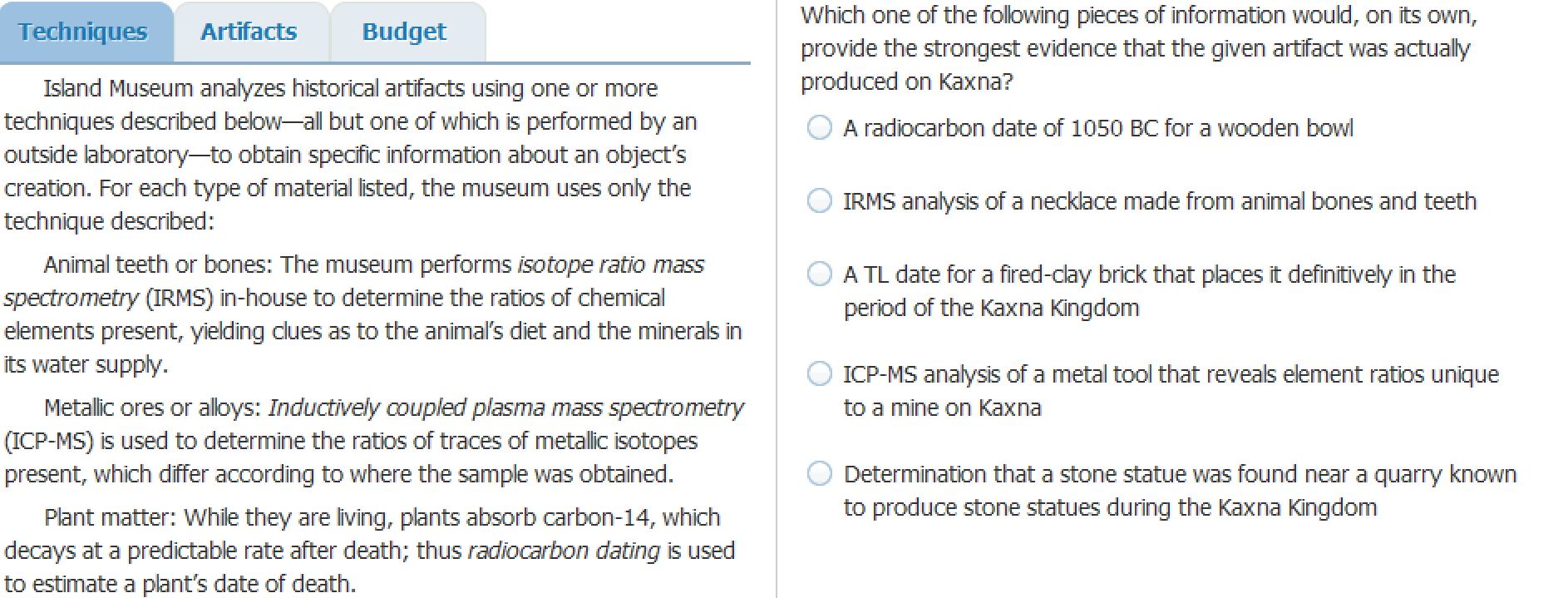
Information may include historical background, statistics, or charts. Note that in this example, you could find out more about ‘Techniques,’ ‘Artifacts,’ or ‘Budget.’ Clicking each tab will display a different set of information.
For these question types, remember that you will be asked more than one question about the same set of data.
In Multi-Source Reasoning, you are being tested not only on your ability to integrate different kinds of information, but also to discern which information is relevant to a given question. Choose wisely. Not all the tabs will be important for every question, and some questions will require you to refer to multiple tabs to synthesize information from different sources.
Want to Identify YOUR GMAT Strengths and Weaknesses?
Our proprietary GMAT Diagnostic Assessment creates a customized study plan for you that takes you from registration all the way to test day! It is included with every account and proven to significantly maximize your score.
Get your personalized assessment as part of your 5 day risk-free trial now:

Graphics Interpretation
Graphics Interpretation questions will require you to answer questions about a table, graph, or chart, like this one:
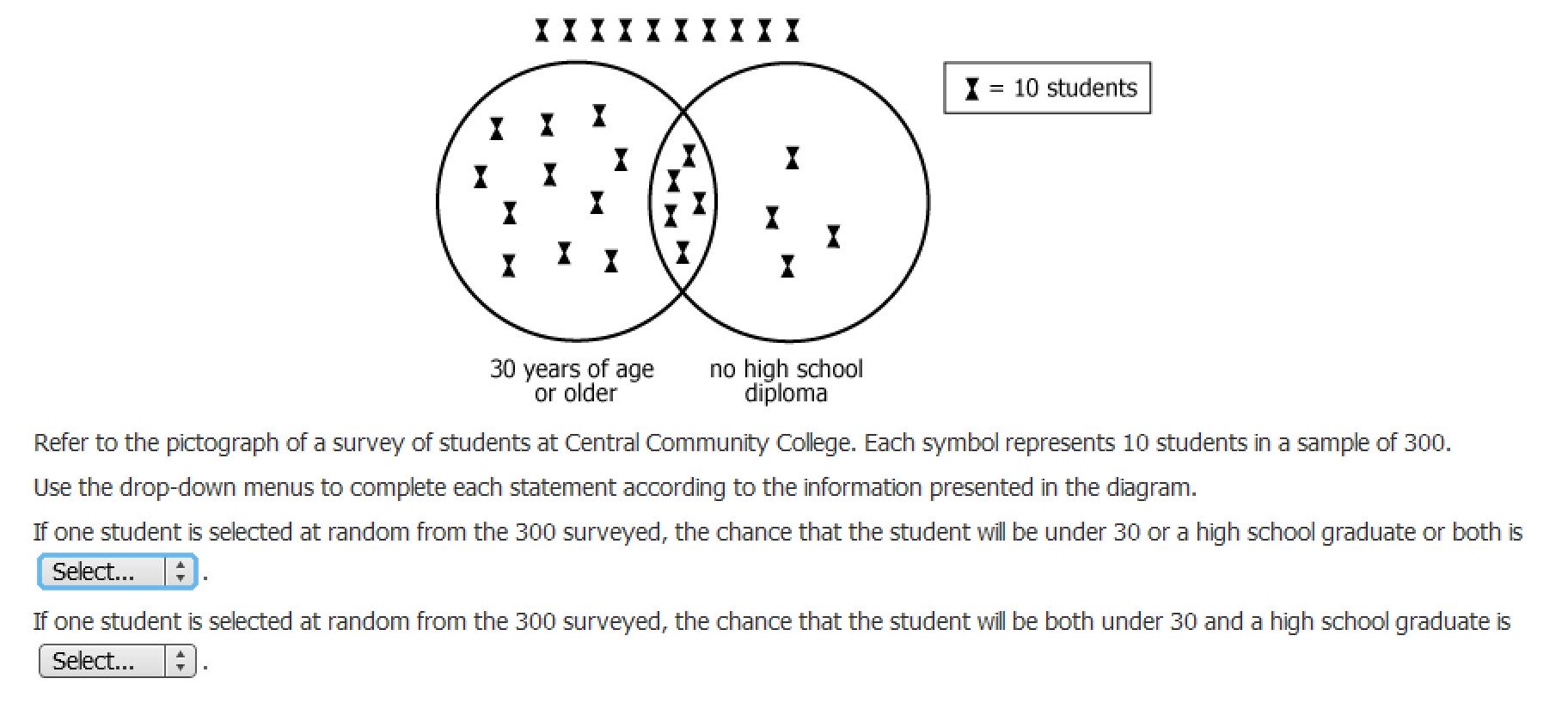
In these questions, you’ll see incomplete statements about the information presented in the graphic. You will use a drop down menu like the one above to make the statements complete and accurate. Choose an answer from each drop down menu. There is no partial credit if you choose only one of the drop-down items correctly.
Two-Part Analysis
Two-Part Analysis questions will ask you to read a passage and solve a two-part ‘word problem’ using two multiple-choice columns:

Here, you would choose one option from the ‘Must not happen in the location’ column and one option from the ‘Must happen in the location’ column.
Read two-part analysis questions carefully; while they may appear simpler than the other question types, they often require you to make inferences based on subtle details in the passage.
Choose only one answer in each column. You cannot choose the same answer for each column. Both must be correct to receive credit.
Table Analysis
In Table Analysis questions, you’ll be asked questions based on tables with a variety of data, like this one:

Each Table Analysis question will ask you if certain statements are True/False or Inferrable/Not Inferrable based on the information available in the table. Choose one answer for each statement.
All of your answers must be correct to get credit for a Table Analysis question. As in the rest of the IR section, there is no partial credit.
Take advantage of the ‘Sort By’ button. This button allows you to organize the table horizontally or vertically based on whatever piece of information you want to highlight. This is a great tool to give you a quick visual shorthand and will help you zero in on the relevant information for the question at hand.
On-Screen Calculator
An onscreen calculator with basic functions is provided for you in the IR section. You can access it by clicking “Calculator” on the upper lefthand corner of your screen.
The calculator will then appear in the center of your screen:
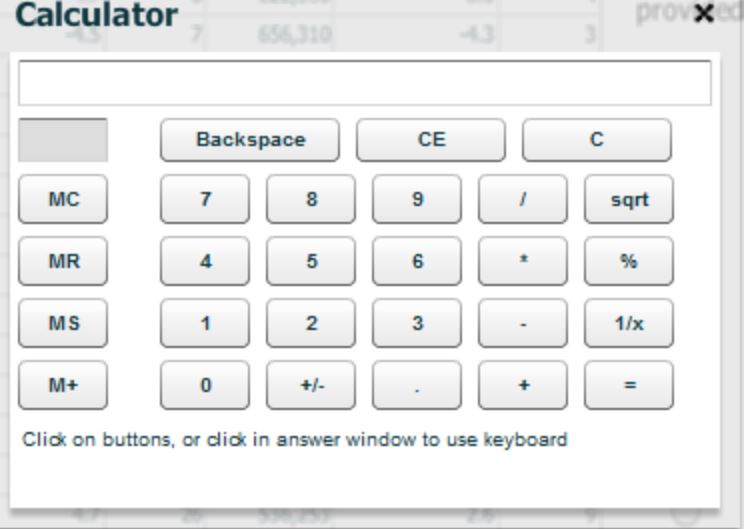 Besides standard arithmetic and square root operations, the IR calculator also includes four memory buttons on the lefthand side:
Besides standard arithmetic and square root operations, the IR calculator also includes four memory buttons on the lefthand side:
- MC, Memory Clear, which clears and resets the memory.
- MR, Memory Recall, which ‘remembers’ and displays whatever is in recent memory.
- M+, Memory Addition, which adds the current entry to the current stored memory.
- MS, Memory Store, which stores in the current memory whatever is displayed on the screen.
The top row has three buttons: Backspace, CE (Clear Entry), and C (Clear All).
The IR calculator doesn’t follow order of operations.
Tips for Succeeding on the Integrated Reasoning Section
- You must answer all parts of IR questions correctly to get credit for them. This can’t be reiterated enough. There is no partial credit for any IR question. If there’s a three-part question and you only get one part incorrect, the question as a whole is marked ‘wrong.’ So, if you’re trying to hurry, don’t guess on the last part of a question just to move on.
- Don’t be tempted to use the calculator too often. It may save you time for basic calculations, but you really don’t need to use it for most of the IR section. Integrated Reasoning doesn’t test your math skills; it tests your ability to make sound decisions and think logically, and you have to do so in quite a time crunch. Don’t let the calculator distract you.

Quantitative Section
The Quantitative (Quant) section of the GMAT test format is 62 minutes long and consists of 31 questions. This section tests your ability to use basic math and quantitative reasoning skills to draw conclusions from given data. There are two question types in the Quant section: Data Sufficiency and Problem Solving.
Data Sufficiency
Like the other sections of the GMAT, the Quant section contains a strong logic component. In that vein, Data Sufficiency questions ask you to consider an initial question and two statements, labeled (1) and (2), and decide whether the statements are sufficient to answer the question asked. Take a look at this example:
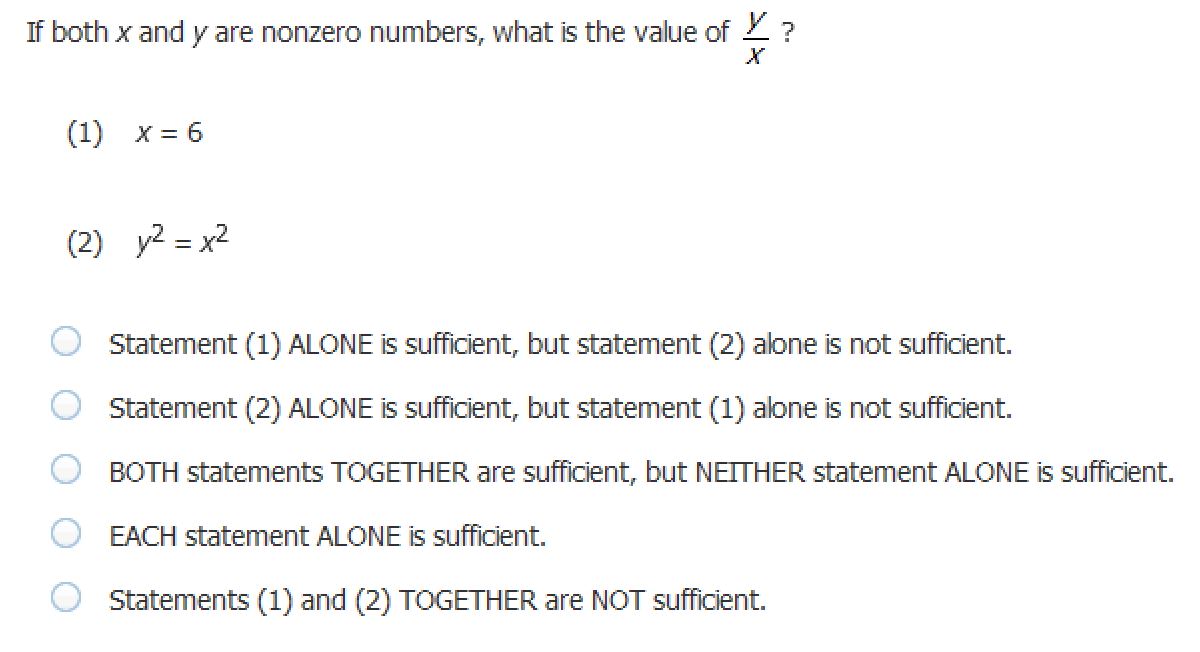
Note that the five choices listed under the question and two statements in this example will be the same for every Data Sufficiency question, so they’re easy to spot.
You should memorize the five Data Sufficiency answer choices before you take the GMAT. This will save you a great deal of time so you only have to consider the given question and two statements, instead of wrestling with the answer choices on top of those, too.
In this context, ‘sufficient’ means ‘I could answer this question fully with ONLY the information in this statement or these statements.’ That means, for example, that the first two choices ask you if, given each statement separately, you could answer the question correctly.
Problem Solving
Problem Solving questions will ask you to choose one multiple choice answer to complete an equation or solve a word problem. Here’s an example:

Problem Solving questions draw from basic knowledge (such as the number of days in a month) and common secondary-level education math skills. In contrast to Data Sufficiency questions, Problem Solving questions are similar to the kinds of questions you might see in the Quantitative section of the GRE, SAT, or ACT.
Tips for Succeeding on the Quantitative Section
- There is no calculator on the Quantitative section. Only the Integrated Reasoning section allows you access to a standard calculator. You can use your erasable notepad to do calculations, but if you review number properties in your preparation for the GMAT, you shouldn’t need to use it much.
- You have about two minutes for each question in the Quant section. Keep track of the time as you go along, and don’t spend too long on any one question.
- The Quant section draws from secondary level math skills like arithmetic, geometry, and algebra. They’re not overly difficult, but you may have forgotten some of the details. A review of these skills will be helpful to you in your exam preparation.

Verbal Section
The GMAT Verbal Section takes 65 minutes and consists of 36 questions. The Verbal section tests your ability to read critically, to make sound inferences and draw accurate conclusions from those readings, and to correct errors in grammar and sentence structure. There are three question types in the Verbal section: Reading Comprehension, Critical Reasoning, and Sentence Correction.
Reading Comprehension
Reading Comprehension questions will present you with a brief passage and questions that ask you about its tone, main idea, details, or structure. Questions may also ask you to draw inferences from the information in the passage. Here’s a sample Reading Comprehension passage:

Reading Comprehension passages are always nonfiction; there is never a fiction/literature passage in the bunch. They might draw from humanities, business-related topics, or the natural or social sciences. However, the exact subject doesn’t that much since you don’t need any outside knowledge to be successful on Reading Comprehension questions.
Generally speaking, there will be one or two longer Reading Comprehension passages (around 350 words) and around three shorter passages (around 250 words). Each Reading Comprehension passage is accompanied by a series of several questions. You will be shown the same passage alongside each one (usually around four).
Critical Reasoning
Critical Reasoning questions ask you to evaluate, unpack (break down), or draw conclusions from a given argument or short passage, like this one:

Pay close attention to what you’re being asked. Are you being asked to make an inference, for example, or to discern the main idea? Knowing will help you choose what to focus on and select a strategy.
Read each answer choice fully before you choose one of the five. There could be subtle missteps that you’ll overlook if you don’t read every answer choice.
Sentence Correction
Sentence Correction questions present a sentence with an underlined portion. Your job is to choose, out of five answer choices, the choice that would best replace the underlined portion of the given sentence:

As in this example, the first answer choice is always a direct repetition of the original underlined portion. The other four answer choices all differ from the original in some way.
In Sentence Correction, you’ll be tested on grammar concepts like punctuation, adjectives and adverbs, phrases and clauses, run-ons and fragments, dangling and misplaced modifiers, and the like. But if you don’t know what some of those are, it’s OK! You need to know about the concepts, not the terms.
Incorrect answers might be grammatically incorrect, redundant, ambiguous, illogical, or otherwise awkwardly written or ineffective. You won’t be tested on spelling.
Tips on Succeeding in the Verbal Section
- You have about a little over a minute and a half for each question in the Verbal Section. Move as quickly as you can without sacrificing accuracy.
- Every question type in the Verbal section requires only one multiple choice answer.
- Read each sentence all the way to the end, particularly in Sentence Correction questions. Sometimes an answer choice will seem fine at the start, but the ending is what’s incorrect. It can be tempting to skim, but if there’s one section where you don’t want to do this, it’s the Verbal section.

Tips: How to Make the GMAT Format Work for You
Whew! Now that we’ve gone through a breakdown of each section, you should have a much better idea of what the GMAT test format will look like onscreen. Familiarity with the question types is a great start on your road to GMAT prep. Here are some other ways to make the GMAT exam format work for you rather than overwhelm you:
- Take a simulated computerized adaptive test. For this kind of a test, doing practice questions on your own probably won’t be enough. Instead, you’ll want to be more familiar with test day conditions so you feel more relaxed the day of the test. You can simulate the real GMAT exam format using the free GMATPrep software, offered by the Graduate Management Admissions Council (GMAC) to everyone with an account at mba.com (also free).
- Familiarize yourself with the format of each section and question type. Recognizing each question type quickly will empower you to approach each question with more confidence and a more effective strategy.
- Don’t be afraid of guessing. There are no penalties for incorrect answers on the GMAT, so don’t be afraid to take a guess and move on to the next question if you’re taking too long. However, if you prepare sufficiently, you will almost always be able to eliminate one or more of the answer choices, which increases your chances of getting the question correct.
- You should always take the optional breaks on exam day. This will refresh your mind and help you mentally ‘reset’ before the next section.
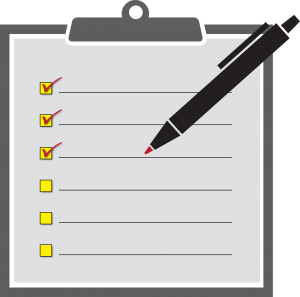
Review: GMAT Format
In this article, we’ve covered the GMAT structure and format, some logistics for test day, the fundamentals of computerized adaptive testing, and a few tips on how to make the most of the GMAT test format. Let’s recap some of the main takeaways:
- There are four sections of the GMAT: Analytical Writing Assessment, Integrated Reasoning, Quantitative, and Verbal. Each one has a different set of question types. You’ll encounter the same question types in each section no matter when you take the test or how well you do on each question.
- You can choose the order in which you want to take the GMAT sections.
- The GMAT is a computerized adaptive test, which means that the test adapts to your skill level as you go along in order to compute your score.
- But on test day, you shouldn’t worry about figuring out whether each question is difficult or easy. Instead, you should focus on answering every question to the best of your abilities.
- Reread this article whenever you need to and take an official computerized test to make sure you’re fully prepared for the GMAT exam format. Familiarity is power!

What’s Next?
Ready to sign up for the GMAT? Read our step-by-step guide on how to register for the GMAT.
Worried about the GMAT section will be too difficult for you? We break down how hard the GMAT actually is.
Curious about how to prepare? Check out our sample GMAT study schedules and tips on building your own prep plan.
 PrepScholar GMAT
PrepScholar GMAT